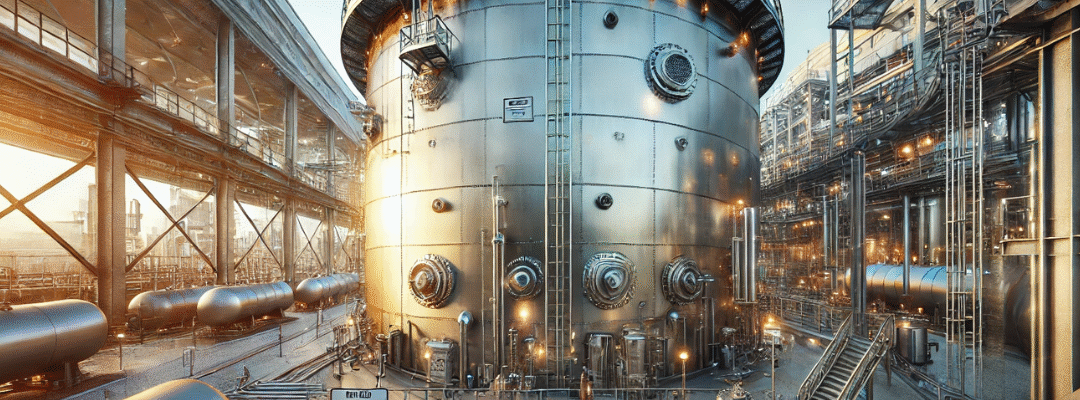Corrosion is the gradual degradation of metal surfaces due to environmental exposure, and it’s a critical concern in tank construction. If left unchecked, corrosion can weaken the tank’s structure, cause leaks, and result in expensive environmental damage and repair costs.
In this post, we’ll explore different types of corrosion, protective strategies, and best practices for prolonging the life of your storage tanks—especially those used in industrial and water storage applications.
Types of Corrosion in Storage Tanks
Chemical Corrosion
Occurs through direct chemical reactions—typically in the absence of electrical current.
Electrochemical Corrosion
Happens when corrosion current flows between different parts of a tank due to electrolyte presence (e.g., water or soil moisture).
Mechanochemical Corrosion
Caused by mechanical stress in combination with a corrosive environment.
External Corrosion
Affects the tank’s exterior, especially when exposed to atmospheric moisture, rain, industrial fumes, or salty environments.
Internal Corrosion
Typically faster than external corrosion. Influenced by:
Frequency of tank loading/unloading
Chemical properties of the stored material
Water content within the product
External Surface Protection
Painting the Tank
To prevent corrosion and enhance tank lifespan, the external surface of above-ground tanks must be regularly maintained using high-performance coatings or lacquer paints. The color of the coating also matters—it should be selected based on light reflection requirements to minimize thermal stress.
Surface Preparation Before Painting
Remove Old Coatings and Corrosion
Use manual tools or mechanical equipment to strip off old layers and surface rust.
Degreasing & Cleaning
Apply a surface cleaner for 3–5 minutes, then wash thoroughly with hot water to remove residues and corrosion particles.
Drying the Surface
Ensure the tank is fully dry at every stage of cleaning to ensure adhesion and prevent rust reformation.
Industrial Coating Application Process
Apply a primer coat using a pneumatic spray gun after surface preparation.
Ensure even application—avoid paint drips to maintain coating integrity.
This process:
Shields the metal from oxygen and moisture
Promotes strong bonding between the steel and the paint layer
Soil Corrosion Protection (Tank Bottom)
Soil-side corrosion of the tank’s bottom is especially dangerous—it can result in undetected leaks that contaminate groundwater.
How to Prevent Soil Corrosion:
Install waterproof membranes below the tank base
Design a drainage layer to redirect groundwater and rainfall
Use electrochemical protection systems (explained below)
Always comply with local environmental and safety regulations
Electrochemical (Cathodic) Protection
This method relies on using a direct current (DC) to protect the tank metal from corrosion.
How it Works:
- A small electric current counteracts the electrochemical reactions that cause corrosion.
- Particularly effective in saline or groundwater-prone areas.
- Note: Overprotection can occur, potentially causing issues such as hydrogen buildup. System calibration is key.
Internal Surface Protection
Protecting the interior of the tank is a more complex and labor-intensive process due to confined spaces and chemical exposure.
Steps for Internal Coating:
Prepare the internal steel surface by cleaning and degreasing.
Apply a primer coat evenly with a spray gun.
Follow with 2–4 layers of high-performance coatings (e.g., epoxy, polyurethane).
Allow each layer to dry completely before applying the next.
This layered coating system creates a chemical-resistant barrier and helps extend the tank’s lifespan—even in demanding environments.
Summary: Best Practices for Corrosion Protection
| Area | Recommended Protection Method |
|---|---|
| External Tank Surface | Regular cleaning and lacquer painting |
| Tank Bottom | Waterproofing + Cathodic Protection |
| Tank Interior | Multi-layer industrial-grade coatings |
| Soil Contact | Drainage, waterproof layers, and monitoring |
| Maintenance | Routine inspections and re-coating |
Conclusion
Effective corrosion protection is not a one-time task—it’s a continuous process that requires planning, correct material selection, and regular maintenance. By implementing these strategies, you can significantly reduce corrosion risks, extend your tank’s life, and ensure environmental safety.
Would you like a downloadable corrosion protection checklist or a comparison chart of coating types for different tank materials? I’d be happy to prepare one.

